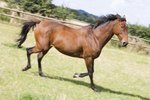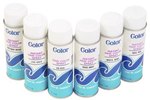
Putting out a feeder or two is like rolling out the welcome wagon for the birds. Chickadees and blue jays love to dine on shelled peanuts while brightly colored finches enjoy sunflower and niger seed. Considering the size difference of bird treats, you may have a difficult time finding bird feeders that accommodate them all. But if you make wire mesh tube bird feeders, you can pick the size of mesh you use for each one, ensuring that the birds will be able to get to the food without it falling too easily through the mesh.
Step 1
Draw a circle around the base of the plastic jug 2 inches up from the bottom using the tape measure and the marker.
Step 2
Place another circle around the top of the jug using the tape measure and the marker. Make this one 4 inches below the cap.
Step 3
Cut the bottom and the top from the plastic jug using the utility knife following the marker lines. Discard the middle part of the bottle but keep the top and bottom pieces.
Step 4
Measure around the outside of the bottom piece of the jug to determine how wide you'll need to cut your wire mesh.
Step 5
Lay out the wire mesh and use the tape to measure how wide it should be. For example, if the circumference of your jug is 10 inches, then you'll need to cut a piece of wire mesh that is 11 inches wide, using the wire cutters. You don't need to cut the length, just leave it at 1 1/2 or 2 feet, whatever the length your mesh is.
Step 6
Roll the mesh into a tube shape, overlapping the edges 1/2 inch.
Step 7
Slip the open ends of the tube into the bottom and top pieces of the jug to ensure that they'll fit easily but snugly. Adjust the size of the overlap, if necessary.
Step 8
Secure the tube edges together using the zip ties, sliding a tie in through one mesh opening along the overlapped seam and up through the opening right next to it. You don't need to place one through every opening in the mesh along the seam, but you should place one each at the top and the bottom and then place three to four more evenly spaced.
Step 9
Cut off the tails of the zip ties using the scissors.
Step 10
Place the bottom jug piece over one end of the tube, and use the nail to poke a hole through every other opening in the mesh 1/2 inch down from the top edge of the jug piece all the way around.
Step 11
Secure the bottom of the tube in place by sliding zip ties through the holes you poked in the jug piece. Do this in the same manner that you used them to fasten the seam of the tube. Cut off the excess ends from the zip ties with the scissors.
Step 12
Poke two holes into the top piece of the jug about 1/4 to 1/2 inch below the cap. Use the nail to create the holes and position them so that they're opposite from each other.
Step 13
Slide one end of the 1 1/2-foot piece of wire up through the bottom of the top jug piece and out through one hole, then bend it slightly and feed it down through the other hole. Pull the wire through and make a pronounced bend in the middle.
Step 14
Secure the ends of the wire to the top of the mesh tube by wrapping one each through a mesh opening on each side of the top of your mesh tube.
Step 15
Slide the top jug piece down into place over the top part of the mesh.
Step 16
Slide a few sticks randomly through the openings to create perches for the birds. You can place as many as you want.
Step 17
Unscrew the cap of the jug to fill your feeder with seed before hanging it in a tree or from a feeder stand.
References
Tips
- The 1/4-inch mesh is ideal for sunflower seeds. Use larger mesh if you want to feed peanuts or other, larger food, or use smaller mesh for more delicate seed such as niger.
- The small perch sticks can either be purchased at a hardware or craft store or can be natural twigs from around your yard.
Photo Credits
-
Michael Blann/Photodisc/Getty Images
Writer Bio
Elle Di Jensen has been a writer and editor since 1990. She began working in the fitness industry in 1987, and her experience includes editing and publishing a workout manual. She has an extended family of pets, including special needs animals. Jensen attended Idaho and Boise State Universities. Her work has appeared in various print and online publications.



